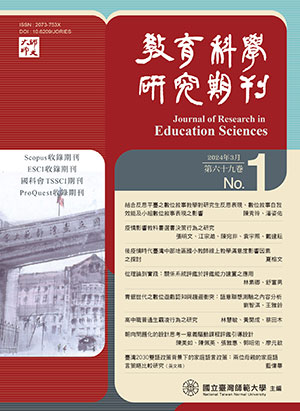 |
 本站僅提供期刊文獻檢索。 本站僅提供期刊文獻檢索。
【月旦知識庫】是否收錄該篇全文,敬請【登入】查詢為準。
 最新【購點活動】 最新【購點活動】
|
| 篇名 |
兒童如何在重複中找到規律?重複樣式的程序性與概念性知識
全文下載 
|
| 並列篇名 |
How Do Children Find Patterns in Reiteration? Procedural Knowledge and Conceptual Knowledge in IdentifyingRepeating Patterns |
| 作者 |
吳昭容 (Chao-Jung Wu)、徐千惠 |
| 中文摘要 |
重複樣式的經驗對於掌握事物的規律性與發展代數思維甚為重要。本文以5 歲和6 歲各30 多名及8 歲兒童40 名進行找單位作業和下一色作業,指出偵測重複樣式的程序性知識包括:設定切割點、編碼、比對、複製或修正的迴路等四個步驟,也討論了限定原則與等長原則等概念性知識。5、6 歲兒童雖有近95%具備兩種概念性知識,卻有25%無法與程序性知識恰當地統整以找到單位。8 歲兒童在實驗所用的樣式結構下,幾乎可完全正確地找到單位,但在預測下一色的作業中卻有生產性的缺陷,會因未採用找單位的方式解題,僅比對序列最前端與最末端群組而犯錯。本文將結果統整在Baddeley(2001)的工作記憶模式與Anderson(1983)的ACT*模式下,指出工作記憶、程序性知識與概念性知識在重複樣式偵測歷程的角色。 |
| 英文摘要 |
Children who explore repeating patterns are able to grasp the regularity in the world and develop algebraic thinking. The authors studied five- to eight-year-old children to investigate how procedural knowledge and conceptual knowledge are used in identifying repeating patterns.Procedural knowledge comprises setting boundaries, encoding, comparing, and loop of reiteration or revision, and conceptual knowledge includes the principles of restricted and equal-length, among others. The procedural and conceptual knowledge of repeating patterns could be interpreted by a “procept”. The eight-year-old children could integrate the procedural and conceptual knowledge to find the patterns, but they had accessibility deficiency and adopted the heuristics only occasionally.The five- and six-year-old children showed evidence of two principles, but some could not integrate the procedural knowledge. Results were applied to the Working Memory Model (Baddeley, 2001) and the ACT* Model (Anderson, 1983). |
| 起訖頁 |
01-25 |
| 關鍵詞 |
重複樣式、捷思法、程序性知識、概念性知識、repeating pattern、heuristic、procedural knowledge、conceptual knowledge |
| 刊名 |
教育科學研究期刊 |
| 期數 |
201003 (55:1期) |
| 出版單位 |
國立臺灣師範大學
|
| DOI |
10.3966/2073753X2010035501001
複製DOI
|
| QRCode |
 |
| 該期刊-下一篇 |
角色楷模課程對高中數理資優女生性別角色、生涯自我效能與生涯發展影響之研究 |
| |